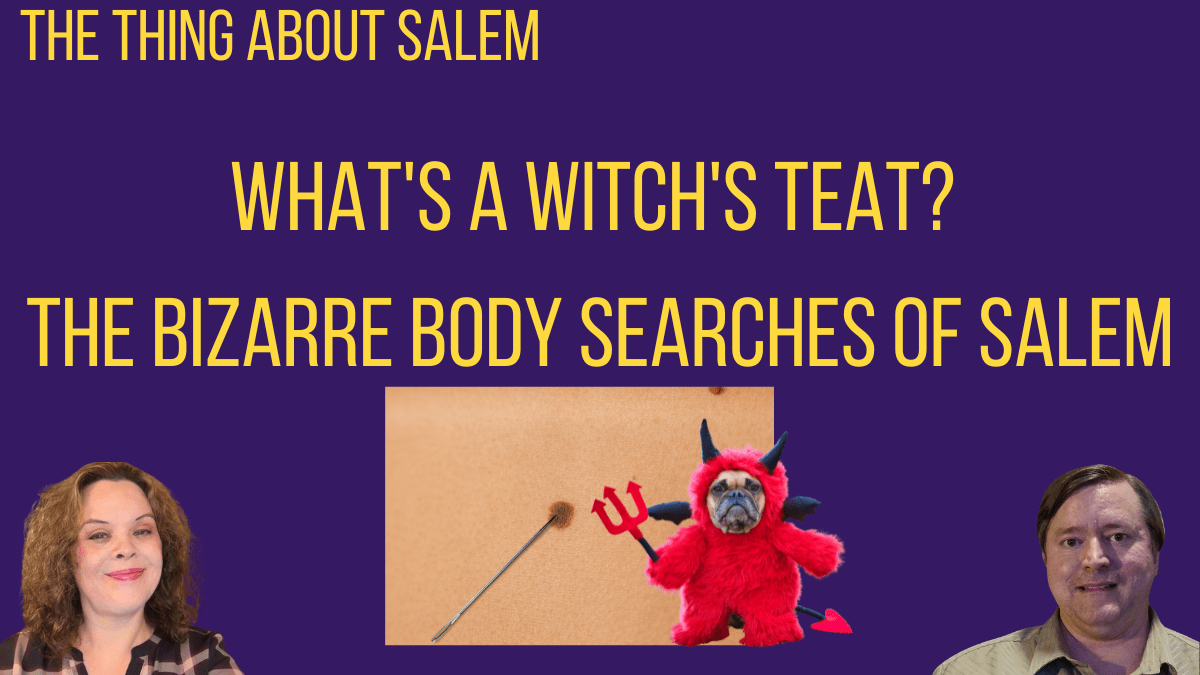In this episode of The Thing About Salem, co-hosts Sarah Jack and Josh Hutchinson examine one of the most invasive and degrading practices used during the Salem Witch Trials: the search for witch’s marks and devil’s teats. Discover how this invented “evidence” was used to convict innocent people—including the hosts’ ancestors.
What You’ll Learn:
The Origins of Witch Mark Theory
- How English legal writers like Michael Dalton (1618) and William Perkins created detailed instructions for finding “devil’s marks”
- Why Richard Bernard claimed these marks appeared in “secretest parts” requiring invasive searches
- The shocking truth: none of this evidence appears in the Bible
Familiar Spirits in Salem
- Cotton Mather’s definition of familiar spirits as “devils in bodily shapes”
- Strange creatures described in testimony: hairless cats with human ears, rooster-monkey hybrids, and hairy upright beings
- How these supposed demons were believed to feed from witch’s teats
The Salem Examinations
- Documented searches of accused witches including Rebecca Nurse, Bridget Bishop, and Elizabeth Procter
- George Jacobs Sr.’s brutal examination with pins driven through his flesh
- Four-year-old Dorothy Good’s traumatic examination and the “flea bite” used as evidence
- Why some marks disappeared between examinations—and what that tells us
Dehumanizing Practices
- The invasive nature of stripping and examining prisoners in their “most intimate areas”
- How postpartum scarring from childbirth was twisted into evidence of witchcraft
- Why the Court of Oyer and Terminer convicted all 27 people tried in 1692—whether marks were found or not
Modern Connections As Robert Calef pointed out in More Wonders of the Invisible World, witch marks weren’t biblical—they were man-made tests designed to find guilt. This pattern continues in modern witch hunts worldwide, where accusers still decide what constitutes “evidence” against innocent victims.
Perfect for listeners interested in:
- Salem Witch Trials history
- Colonial American history
- Wrongful convictions and false evidence
- Women’s history and bodily autonomy
- Modern witch hunts and human rights
- Historical witchcraft accusations
- Legal history and justice reform
Featured Historical Sources:
- William Perkins, A Discourse of the Damned Art of Witchcraft
- Michael Dalton, The Countrey Justice (1618)
- Richard Bernard, The Certainty of the World of Spirits
- Cotton Mather, Wonders of the Invisible World
- Robert Calef, More Wonders of the Invisible World
- Deodat Lawson, A Brief and True Narrative
- Original Salem Witch Trial examination records
About the Hosts: Sarah Jack and Josh Hutchinson are descendants of Salem witch trial victims and co-founders of End Witch Hunts, a nonprofit addressing modern witch hunts globally. Together, they co-host The Thing About Salem and The Thing About Witch Hunts (265+ episodes).
Support Our Work: Learn more about modern witch hunts and how to help at EndWitchHunts.org
Links
Salem Witch Trials Documentary Archive and Transcription Project
Records of the Salem Witch-Hunt
The Thing About Witch Hunts YouTube
The Thing About Witch Hunts Website
Sign the Petition: Exonerate Those Accused of Witchcraft in Massachusetts

Leave a Reply